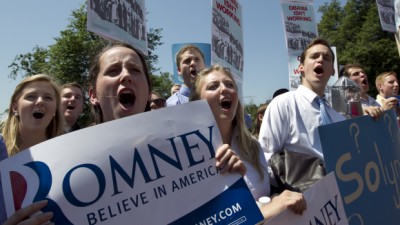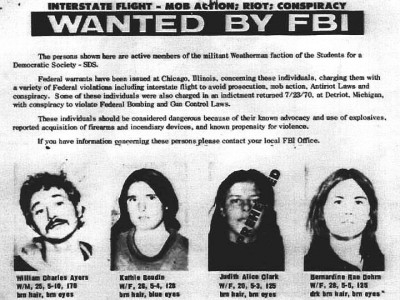SUA Staff – Why should we take a long, hard look again at David Axelrod? Because few paid attention before, when Obama and his associations were not properly vetted prior to 2008 and yesterday when he publicly told Republican attendees at a rally in Boston, that they “cant handle to the truth”. Tough line; one that sounded good when Jack Nicholson used it in the movie “A Few Good Men“, but can Axelrod stand the scrutiny himself?
Axelrod took a bold step standing in Romney territory spouting pro-Obama double-speak and Romney bashing. The Tea Party faithfuls would have none of that. The chants were so loud from Republicans, that Axelrod actually had to stop and address his opposition.
Just why is there such hard line opposition to Axelrod and his mission to re-elect Obama? Lets take that deeper look. Just recently, the American Spectator took a thorough historical sweep of Axelrod and his friends. One that today gives new insight into Chicago thuggery, and a new understanding of their beliefs in Communism and Marxism. Its a long story, but well worth the time to soak up who David Axelrod is and what motivates him and his crew.
Here is a powerful excerpt from that article:
…And these figures reveal that Axelrod—just like Barack Obama—is the product of some far-left influences, from the progressive left to the communist left. Like Obama, who was impacted by Frank Marshall Davis, Bill Ayers, Jeremiah Wright, and others, these figures unquestionably had an impact and surely help explain why Axelrod is on the left—and not the moderate left. Moreover, it is telling, but not surprising, that the mainstream media has dared not touch these influences, surely fearful of the danger of exposing them and their possible impact on today’s Oval Office.
It also shows how manufactured Obama is, how his message is not really his, rather its the message of a leftist king-maker. Axelrod, the perennial king-maker, has used the same theme for years.
The Boston speech and heckling, along with Axelrod’s words prompted Jennifer Rubin in her column “Axelrod Adrift”, where she shows us briefly the stark similarity in each of Axelrod’s political ventures as a king-maker:
If David Axelrod seems befuddled these days, even inadvertently making the case for “change” from the status quo (i.e., the Obama administration), it might be because all he has ever done is run races on “hope and change.” Over and over and over again.
Here are the similarities she mentions. In the case of Massachusetts Governor Deval Patrick in October 2006 proclaimed:
“This election is a race between hope and fear, between division and community, between responsibility and blame, between whether we have the courage to change, to stay young forever, or whether we stay with the comfort of the status quo.”
…2004, when Axelrod teamed up with John Edwards. Edwards may have coined the insipid “two Americas,”
Going back to 2002, David Axelrod was touting Carl McCall for New York governor. And don’t you know it? Axelrod was telling voters that his candidate was “making the case for change.”
You can find the identical Axelrod message going back to the 1994 midterms, and before that to Richard M. Daley’s race for Chicago mayor in the late 1980s. There Axelrod was again, telling voters: “Chicago needs a change.”
Back to his formative times as an adult in politics and some critical excerpts from that American Spectator article by Paul Kengor:
When it comes to influence, a common bond among these fellow travelers, from the mentors to the mentored, is political work for African-American Democrats. David Canter and Don Rose seem to have had an influence not only on Axelrod’s politics but on his work in politics.
…After several busy years at the Tribune, he left his spot as one of the paper’s youngest political writers for the lure of political campaigns. His big break came not with his work on Harold Washington’s 1987 reelection campaign but with Illinois Senator Paul Simon. He first worked for Simon in 1984, before being hired to run Simon’s 1988 presidential bid.
He also gained quite the negative reputation and an affinity for African-American Democratic candidates:
Early on, Axelrod likewise gained a reputation for going negative. AChicago Magazine profile from December 1987, titled, “Hatchet Man: The Rise of David Axelrod,” stated: “Axelrod’s holier-than-a-hack image is also soiled by a penchant for airing negative television commercials.” Here, too, Axelrod was described as “creative” but “mercurial,” “tense,” filled with “anxiety” and impatience, “by nature nervous” and ever-ready to “blast the dickens” out of an opponent.
…Democrat office-seekers apparently admired the tactics, or the results. The clients came running, with the Ax honing a sharp affinity for African-American candidates, particularly mayoral prospects: Harold Washington in Chicago, Michael White in Cleveland, John Street in Philadelphia, Anthony Williams in Washington, Lee Brown in Houston. Like David Canter, he encouraged and helped black candidates appeal to white voters.
Soon he moved on to Mayor Daley in Chicago and became very close to Rahm Emmanuel. He became associated with larger and larger campaigns, and therefore the fees rose. He also made enemies in his own party like Pat Caddell, now a familiar face on news programs as a Democrat. Soon, his firm, AKP&D in partnership with John Kupper, David Plouffe, and John Del Cecato. He was also working with ASK Strategies with the addition of Eric Sedler.
In one way shape or form, he was performing well:
…four presidential campaigns and numerous senatorial, congressional, gubernatorial, and mayoral campaigns, with names ranging from Barack Obama to John Edwards, from Rod Blagojevich to Eliot Spitzer, from Patrick Kennedy to Rahm Emanuel.
Meeting Obama:
Though it seems very likely they would have met in Chicago in the 1980s, liberal lore maintains that Axelrod and Obama were introduced in 1992 by Bettylu Saltzman, who the New York Timescalls “a Democratic doyenne from Chicago’s lakefront liberal crowd.” Saltzman met Obama at a 1992 black voter registration drive. She was blown away, telling friends she had met a man who would become the first black president. She immediately began introducing Obama to wealthy liberal donors-and to David Axelrod.
The old ties and the new meet, and the separation between Axelrod, Obama, and their ‘terrorist friends’ was something they constantly tried to widen in vain:
…Marilyn Katz, an old SDSer and Vietnam War protester who once threw nails in the Chicago streets to slow the police. Marilyn is pals with Don Rose and Carl Davidson, old SDS cronies. Davidson, one of SDS’s national leaders, and a dear friend of Bill Ayers and Bernardine Dohrn, would become webmaster for the 2008 group, Progressives for Obama.
On to the Presidential run:
Axelrod saw in Obama a triumph of personality and image—not policy. Ax would be the shaper and keeper of the message—of hope and change. Says Donna Brazile, Democrat strategist, every Obama “let us” phrase in 2008 was Axelrod’s doing. “Yes, we can!” was as much Axelrod as Obama.
Even Karl Rove and his own mother were impressed at Axelrod’s abilities:
“What Mr. Obama and his team achieved was impressive,” said Rove, in an understatement.
Myril Axelrod. Still alive and still somewhere on the left, the aged ex-writer for PM danced in pleasure at her nursing home in Newton, Massachusetts. She also attended the inaugural ball. “Never in my lifetime have I seen something like this,” she thrilled. “It’s an extraordinary experience.”
With Axelrod, it all started with his mother:
Axelrod’s mother, Myril Bennett Axelrod, worked for the left-wing New York newspaper, PM. Although it lasted less than a decade (1940-48), PM became notorious because of its penetration by Stalinists and others who promoted the Communist Party line on issues both foreign and domestic. Kengor points out that PM‘s famed Washington correspondent, I.F. Stone, was subsequently identified as a Soviet agent both in the so-called “Venona” documents and also by a former top KGB official, Oleg Kalugin.
The hypochrisy:
While Axelrod decried these alleged diabolical GOP special interests and their obscene money-grubbing, his firms had raked in more than their “fair share” of obscene profits.
Bloomberg reported that Axelrod’s AKP&D and a Washington-based firm called GMMB profited handsomely from Obama’s health care reform. “Two firms that received $343.3 million to handle advertising for Barack Obama’s White House run last year have profited from his top priority as president by taking on his push for healthcare overhaul,” reported Bloomberg in August 2009. ”
One is AKPD Message and Media, the Chicago-based firm headed by David Axelrod until he left last Dec. 31 to serve as senior adviser to the president. Axelrod was Obama’s top campaign strategist and is now helping sell the healthcare plan.” (There is more here as well, read the rest here.)
The split that was not a split. He did not get replaced by Plouffe as much as it was time to see family, rejoin Rahm Emmanuel, and get back to what he does best, get his leftist friends elected or re-elected, and now we see him in places like Boston, with the same old tried and true negative politics and those hollow words of “hope and change.”

